
25 Instagram Statistics You Need to Know in 2025
Discover 20+ essential Instagram statistics that reveal the platform's reach, effectiveness, and continued growth.

Content Writer @ Buffer
Instagram isn’t just a photo-sharing app anymore. In 2025, it’s a digital town square — part search engine, part shopping mall, part entertainment hub, all rolled into one ✨aesthetic✨ platform.
It’s where creators build brands, where brands tap into culture, and where billions of users scroll every day.
We’ve pulled together the most important Instagram statistics for 2025 — blending industry-wide research with real insights from Buffer’s tools and data — so you can make informed decisions about your Instagram strategy this year.
Whether you’re there to build reach, drive revenue, or just stay visible in the scroll, these numbers will help you understand what’s happening on Instagram and why it matters.
Let’s dive in.
Instagram by the numbers: How big is the platform?
Before diving into strategy, let’s start with the size and shape of Instagram in 2025 — who’s on it, where they are, and how fast the platform is still growing. Because even if Instagram isn’t the newest app on the block, it’s still one of the biggest — and one of the most deeply embedded in how we share, discover, and connect online.
Instagram has over 2 billion monthly active users — and counting
Instagram hit 2 billion monthly active users — and it happened in just over 11 years, reaching the number faster than Facebook and YouTube. With that many eyes on the content of brands and creators, there’s more than enough opportunity to grow on the platform.
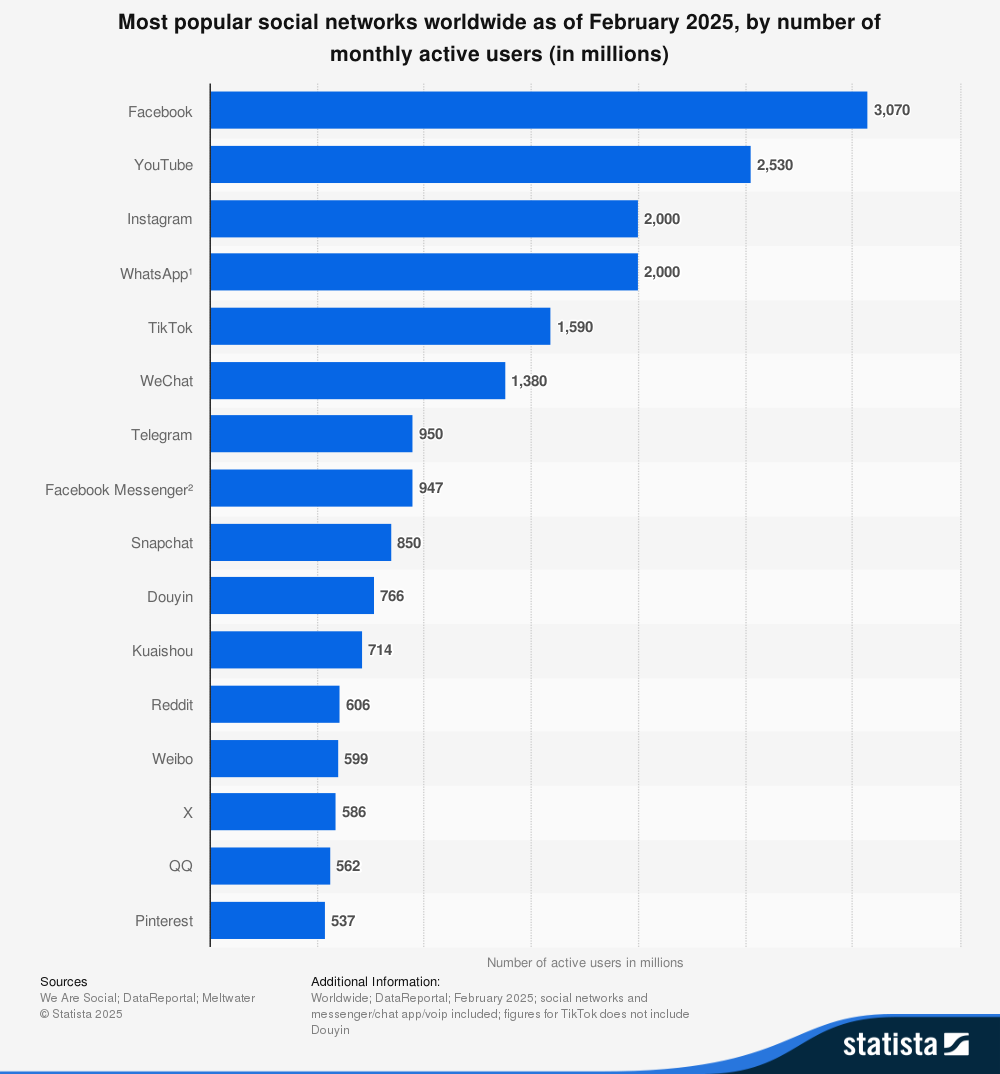
India, the U.S., and Brazil top the charts — but other countries are climbing fast
The countries with the largest Instagram user bases are:
- India: 414 million
- United States: 172 million
- Brazil: 141 million
- Indonesia: 103 million
- Turkey: 58 million
- Japan: 57 million
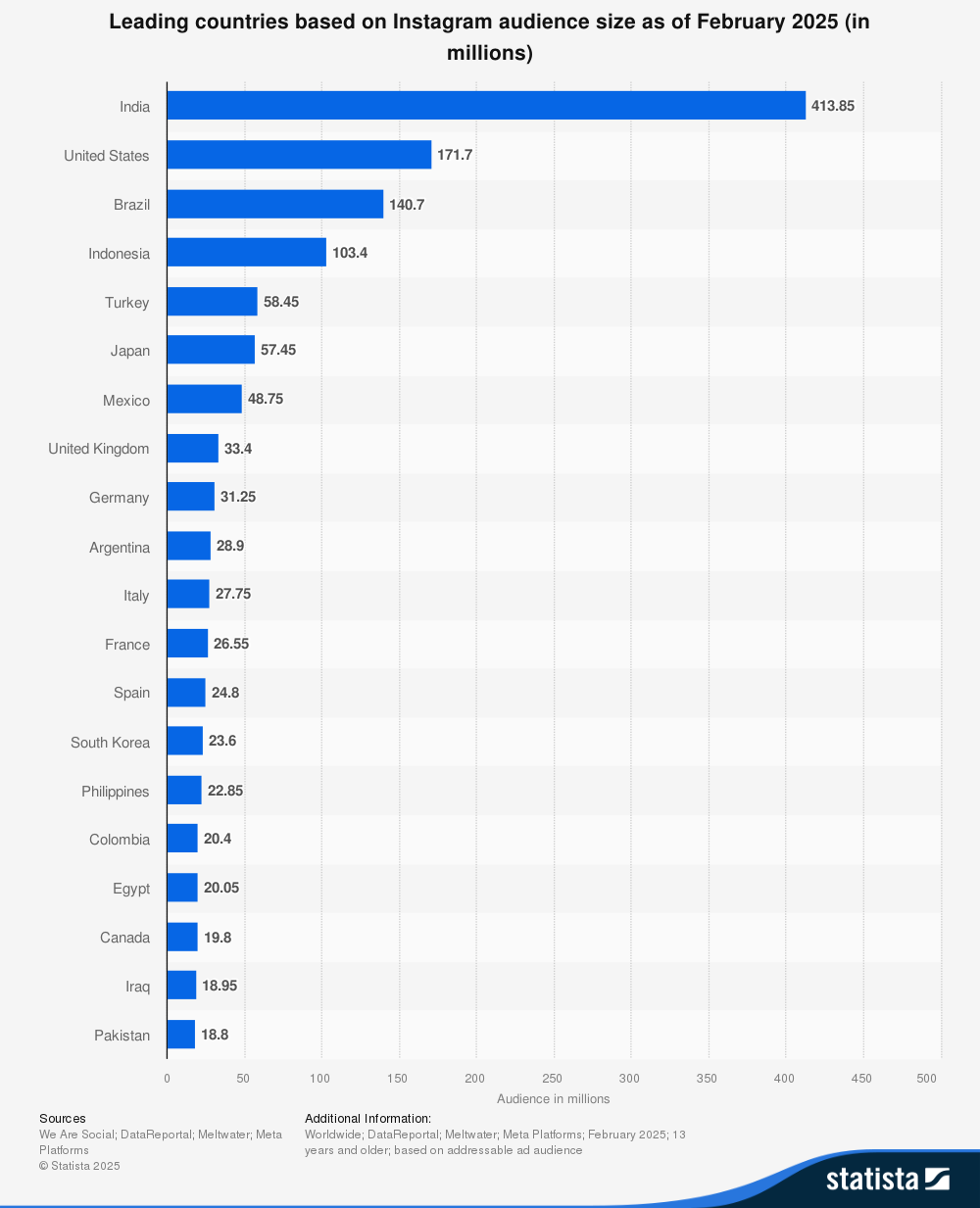
But size isn’t the only story. When it comes to uptake — the percentage of a country’s population that uses Instagram — you’ll find small nations like Kazakhstan (89.3%) ahead of the pack.
Turkey also has a high Instagram audience uptake rate (88.8%) of the population using the social network. In Uruguay, the United Arab Emirates, and Brazil, the photo-sharing platform is used by more than 86% of each country's population.
This information is handy for marketers running international campaigns. A country might not have that many users, but higher uptake might offer stronger community engagement than a massive user base that’s more passive.
Southern Asia holds the largest regional share of Instagram users
Broken down by region, Southern Asia now accounts for over a quarter of all Instagram users worldwide, with India as the clear heavyweight. The full picture:
- Southern Asia: 448 million users
- South-Eastern Asia: 177 million
- Northern America: 192 million
- Southern America: 237 million
- Western Europe: 78 million
- Western Asia: 133 million
- Eastern Asia: 101 million
- Africa (all regions combined): ~91 million
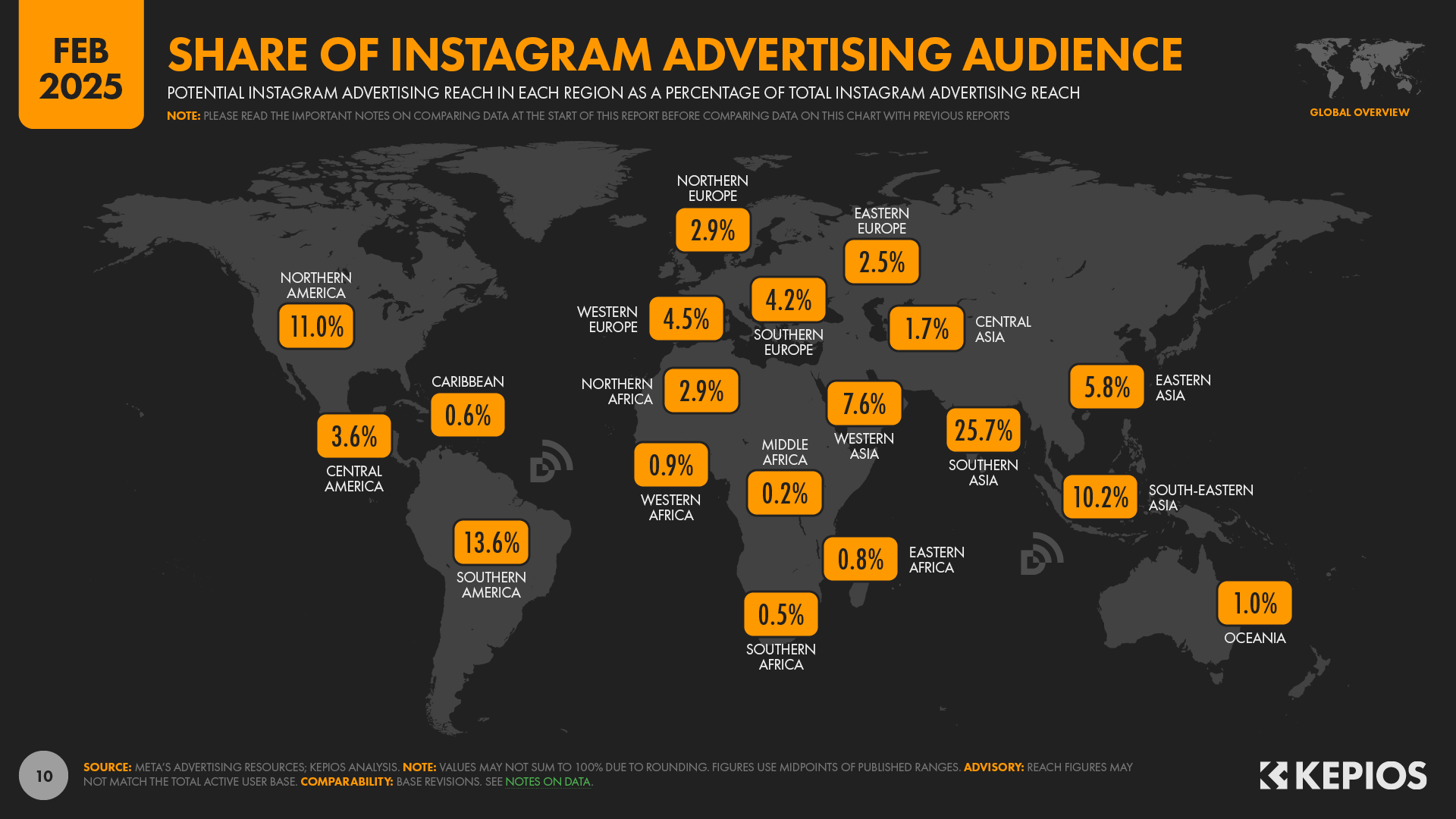
If your audience spans more than one country or continent, these stats are a reminder to think regionally — not just nationally — when planning your Instagram strategy.
84% of social users have an Instagram profile
Instagram doesn’t just dominate by user count — it’s also the most widely adopted platform among global internet users with a social media presence. According to recent reports, 84% of social media users have an Instagram account. That’s more than TikTok, YouTube, or even X (formerly Twitter).
While this stat doesn’t tell you how often people post or engage, it confirms one thing: Instagram is still the default social identity for most people online.
Instagram connections in Buffer have nearly doubled since 2022
Among the 11 social networks our users can connect to Buffer, Instagram has grown 94.7% since 2022, climbing from 657,000 to 1.28 million total channel connections, with 104,000 of those accounts actively publishing through Buffer today.
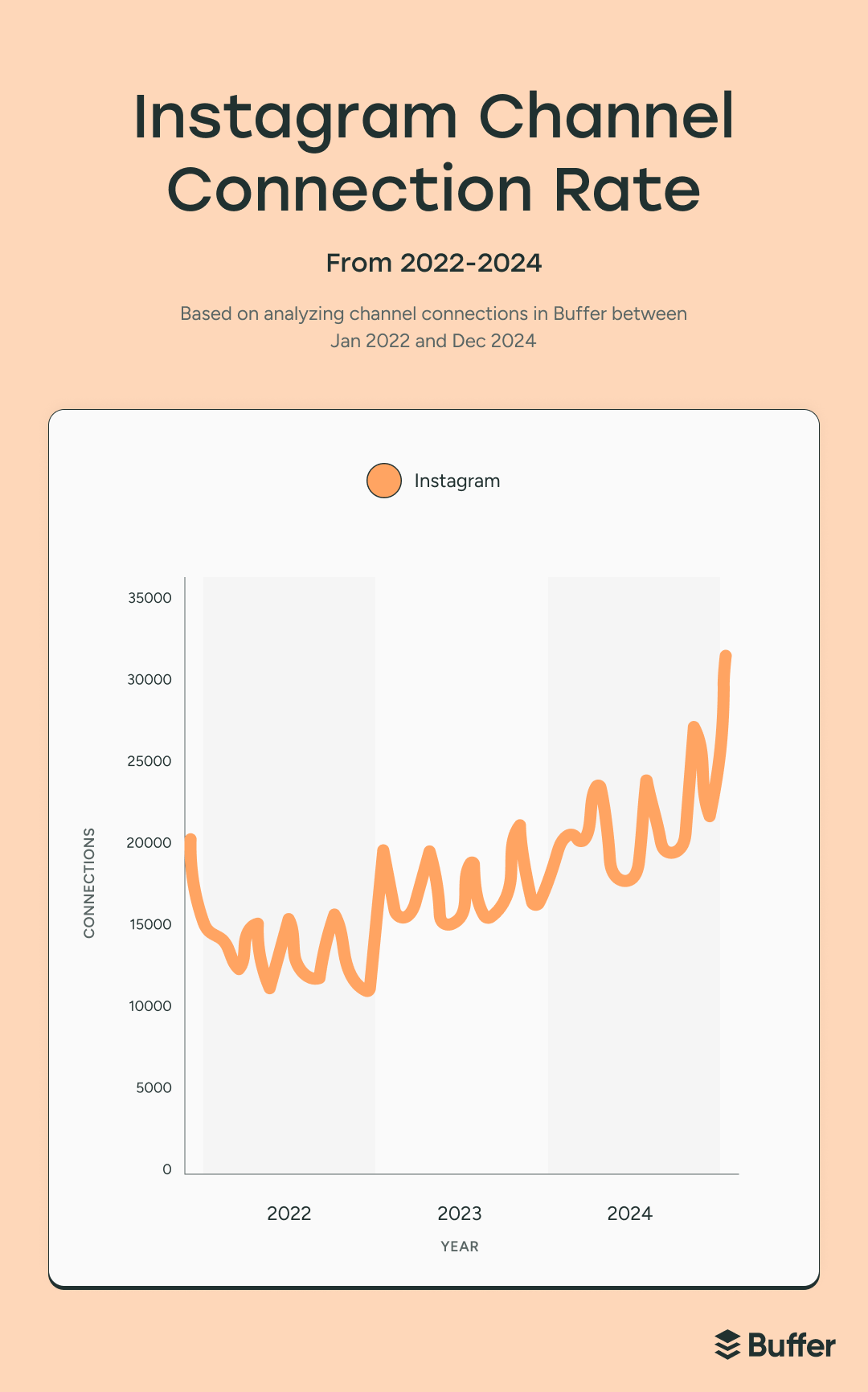
This internal spike confirms Instagram’s staying power for creators and small businesses alike.
Who’s on Instagram: Demographics in 2025
Knowing how many people use Instagram is one thing — but understanding who they are is what actually drives smart content decisions. In 2025, Instagram’s audience skews young, global, and increasingly balanced across gender. But there’s nuance in the numbers — and opportunity in the margins.
The average Instagram user is aged 25–34
The data puts the average user in the 25–34 age bracket, a sweet spot for both creator and consumer content. This age group makes up the largest share of global users, followed closely by 18–24 year-olds.
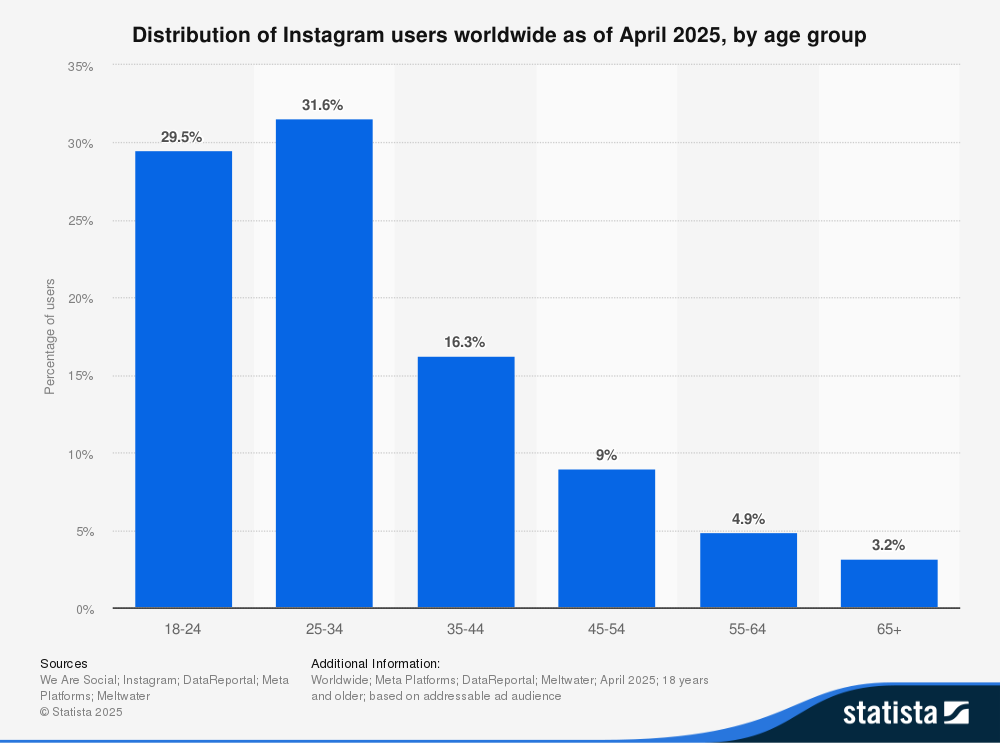
But don’t mistake that for a Gen Z monopoly. There’s a solid presence of users in their 30s, 40s, and even 50s — especially in Western countries, where the platform has matured alongside its user base.
So if you’re only creating content for Gen Z, you may be overlooking a high-intent, high-spending segment just outside that range.
Users aged 18–34 account for over 60% of Instagram’s global audience
Here’s the age breakdown across key groups:
- 18–24: 31.7%
- 25–34: 30.6%
- 35–44: 16%
- 45–54: 8.7%
- 55–64: 4.6%
- 65+: 2.9%
This split shows that while Gen Z and Millennials are still the dominant force, 1 in 3 users are older than 35. That opens the door for more lifestyle, family, finance, and career content that speaks to an aging-but-active cohort.
Additionally, Meta reports that male users aged 25–34 make up the largest single segment on the platform.
The gender split is nearly even — and still shifting
Globally, Instagram’s gender distribution in 2025 is 52.5% male and 46.5% female — a near balance. In some regions, like the U.S., women actually edge ahead in usage. And while Meta’s data still reports only binary gender categories, the trend is clear: Instagram is no longer skewed to one side.
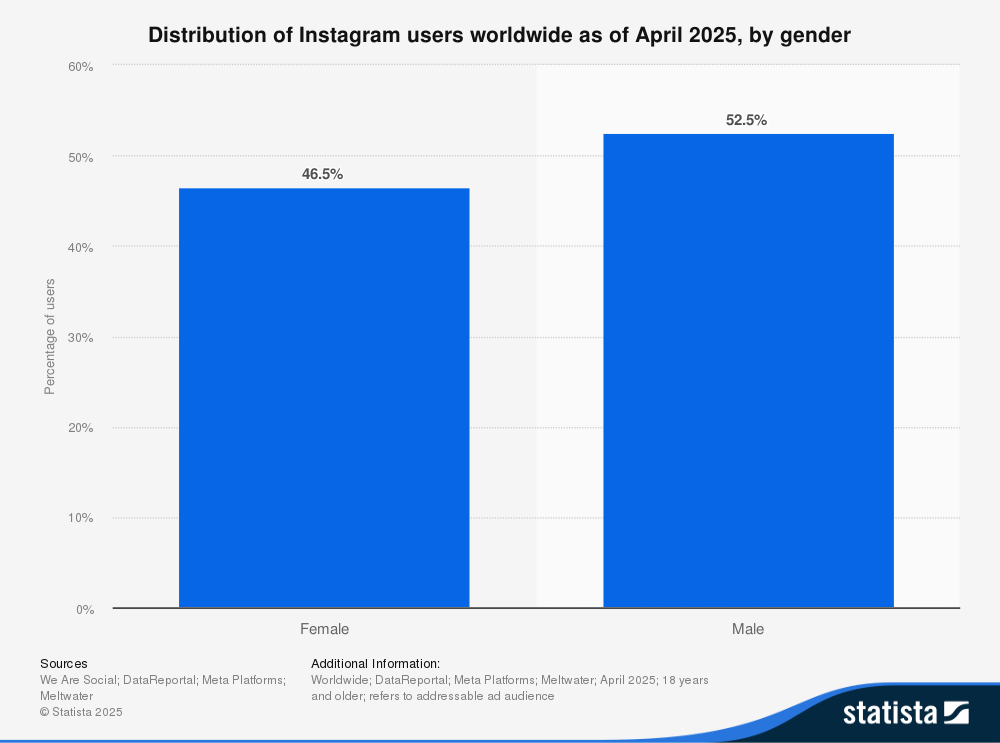
This means you’re not speaking to just one demographic. Your content should reflect a mix of perspectives (or at least not assume a default voice).
Demographic makeup varies widely by country
In India, the platform skews towards male, younger audiences. In the U.S., it leans female with more representation across the 25–44 age range. Emerging markets like Indonesia and Nigeria show rising Gen Z adoption, while Western Europe sees stronger retention in older brackets.
“Instagram users” is not a monolith. If you’re marketing globally (or even regionally), it pays to check the local data, not just the global averages.
How people use Instagram in 2025
Instagram isn’t just a place to post — it’s a place to explore, connect, message, shop, and scroll for hours. While the platform might look like one big feed, it’s really a network of micro-behaviors.
Understanding how people actually use Instagram in 2025 helps you create content that meets them where they are — and how they like to engage.
People spend 12 hours/month on Instagram
Most Instagram users spend an average of 33 minutes per day on the platform. That’s less than TikTok (53 minutes), but ahead of platforms like Snapchat and Facebook.
What this tells us: Instagram hits a sweet spot. It’s more “scrollable” than LinkedIn or Pinterest, but still feels intentional — a platform where people come to consume, but also to create, comment, and connect.
91% of Gen Z have a profile — but they’re not the only ones posting
Instagram remains Gen Z’s go-to social platform, with 91% of Gen Z users maintaining a profile. But they’re not the only ones engaging. Over 32% of the platform's global audience is aged 35 and up, and many of them are actively gathering Instagram followers, not just lurking.
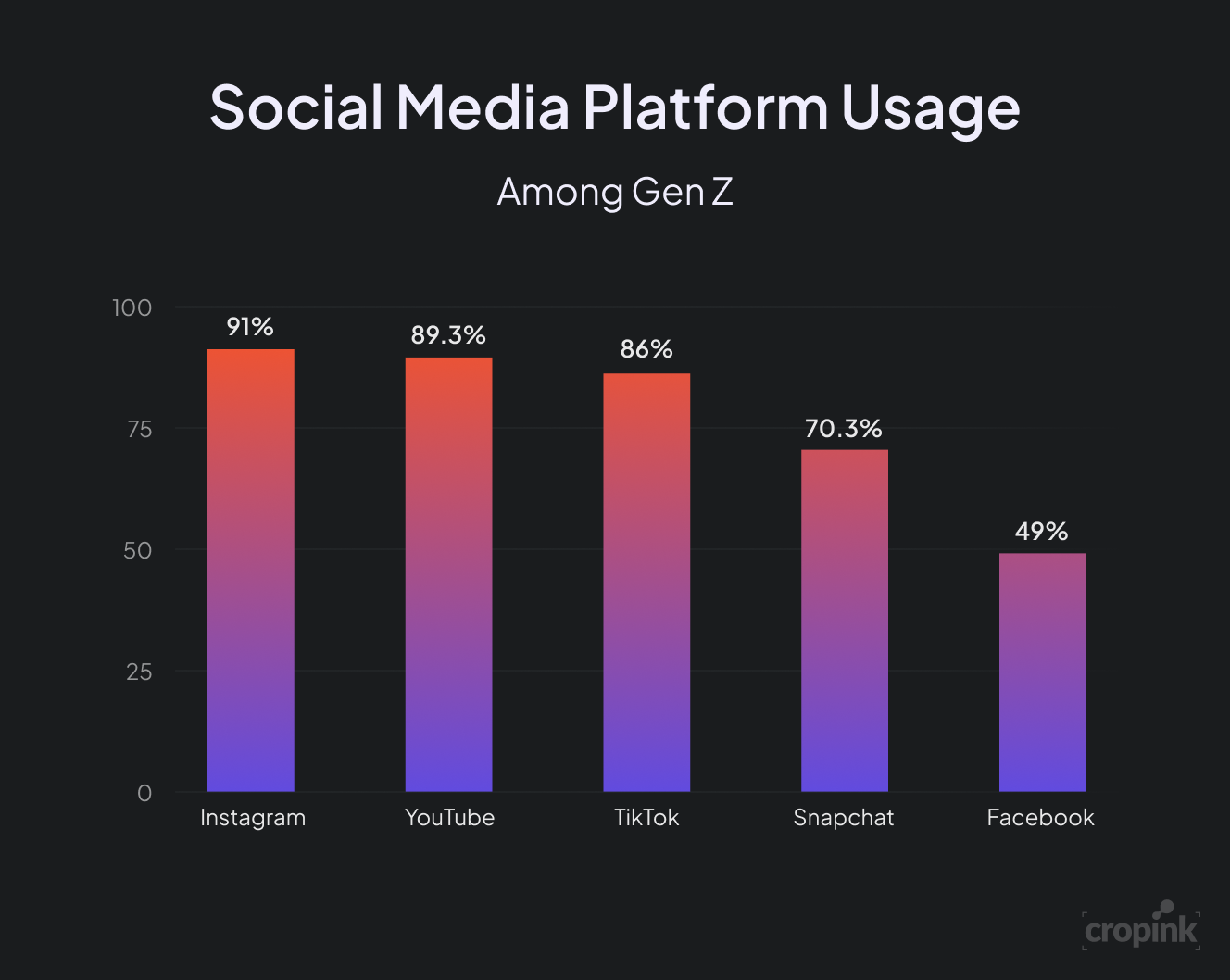
If you’re creating content that only targets one generation, you might be missing the full opportunity.
Create in formats Gen Z favors (reels, stories), but use messaging that resonates across age groups — like education, value, or personal storytelling.
Instagram users also use other platforms
Only 0.2% of Instagram users use it as their only social platform. The rest are active elsewhere:
- 80.3% also use Facebook
- 76.9% also use YouTube
- 54.3% also use TikTok
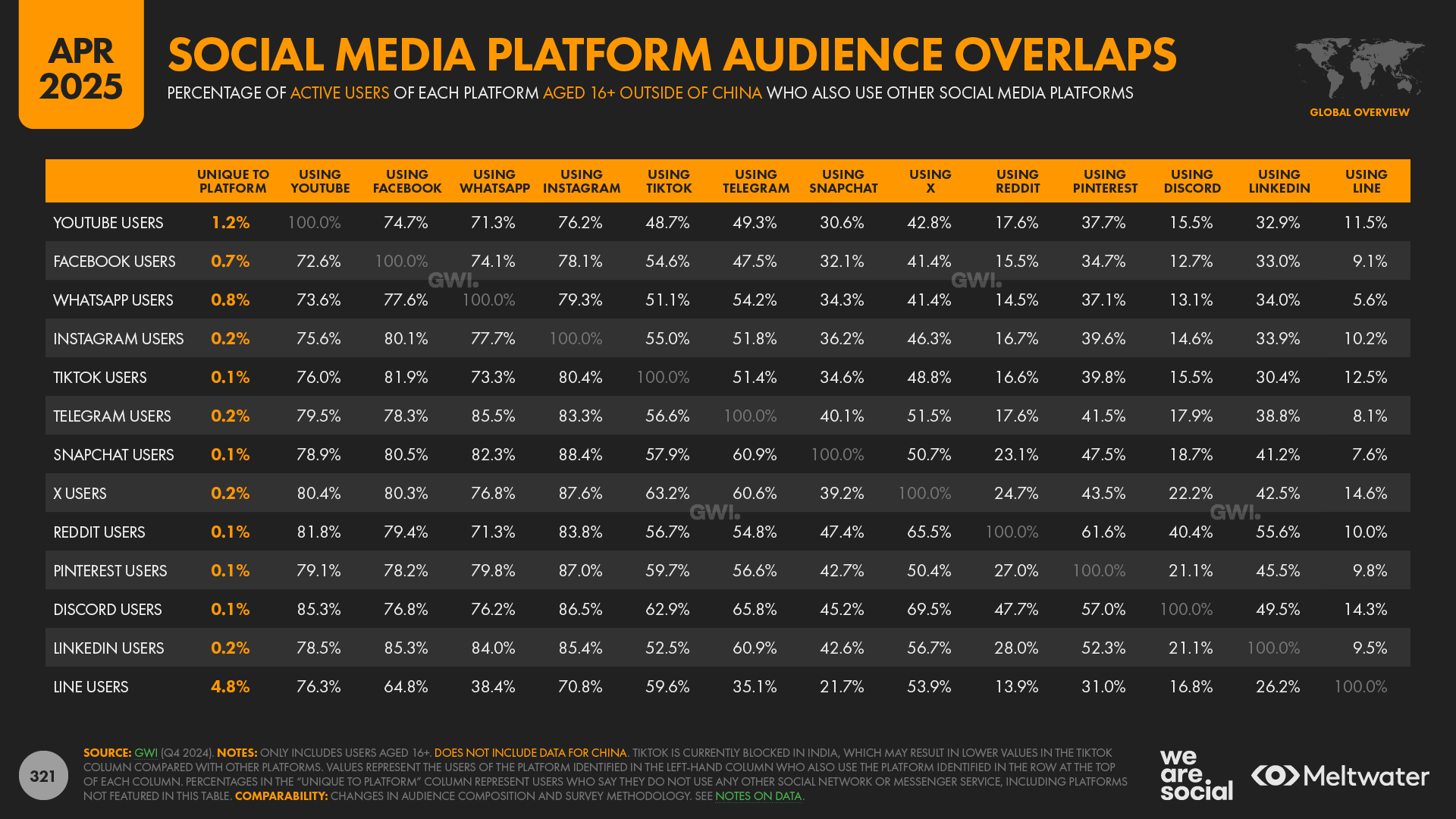
This makes Instagram a perfect place to reinforce — not repeat — your brand or creator message. Think cross-posting but specific to each platform: behind-the-scenes from a YouTube upload, shorter takes from a long LinkedIn post, or expanded ideas from a trending Reel.
Those overlaps echo our data: creators aren’t replacing Instagram — they’re layering it into an ecosystem of text-first apps, short-form video feeds, and carousel-friendly networks. Repurposing isn’t optional anymore; it’s how modern audiences actually consume.
Users are spending less time on static content — and more on video
While users still post more single images than any other format, the time they spend engaging has shifted. Meta reports that reels now account for over 50% of time spent on Instagram.
View on Threads
This means that video is no longer optional. Luckily, it doesn’t have to be high-production. Reels, stories, and behind-the-scenes moments all drive time-on-platform. And if video just isn’t your thing, don’t worry — by adding music to carousel posts, your content will still show up in the reels and suggested content feeds.
Engagement is shifting to Instagram direct messages
In our report on average engagement rate across different social platforms, we found that in January 2024, Instagram’s median engagement rate was 2.94%. By January 2025, it had adjusted to 0.61%.

This change reflects a broader shift in how users engage with content rather than a loss of platform relevance.
But the average engagement rate on Instagram isn’t disappearing — it’s moving behind the scenes. You need to create content that people want to interact with publicly and share privately. Think saveable, shareable, or response-driven.
For creators and brands alike, direct messages have become a go-to place for audience questions, customer support, feedback loops, and even sales conversions.
Meta has emphasized the "growing importance of private messaging" across all their platforms. They noted a shift in user behavior from feed engagement to “meaningful private interactions”, leaning in with features like Instagram Broadcast Channels, DM automation tools, and shopping integrations directly inside chats.
So if your only call-to-action is “comment below,” you might be missing half the conversation. Treat your inbox like a micro-community — set up a broadcast channel, use DM automation tools, and engage your audience directly.
How content performs on Instagram
You’ve got the audience. You’ve got the strategy. But if you don’t know how each format actually performs, you’re guessing in the dark. In 2025, content on Instagram behaves differently depending on format, the size of your account, and how users engage across feeds. The following Instagram statistics break down what’s working — and what isn’t — so you can create with purpose.
Reels still dominate reach, especially for small accounts
In our analysis of over 4 million Instagram posts, we confirmed what many creators already know: Reels consistently outperform all other formats for reach.
- Reels get 36% more reach than carousels
- 125% more reach than single-image posts
The Instagram Reels feed itself is built for discoverability — meaning even small accounts can go viral
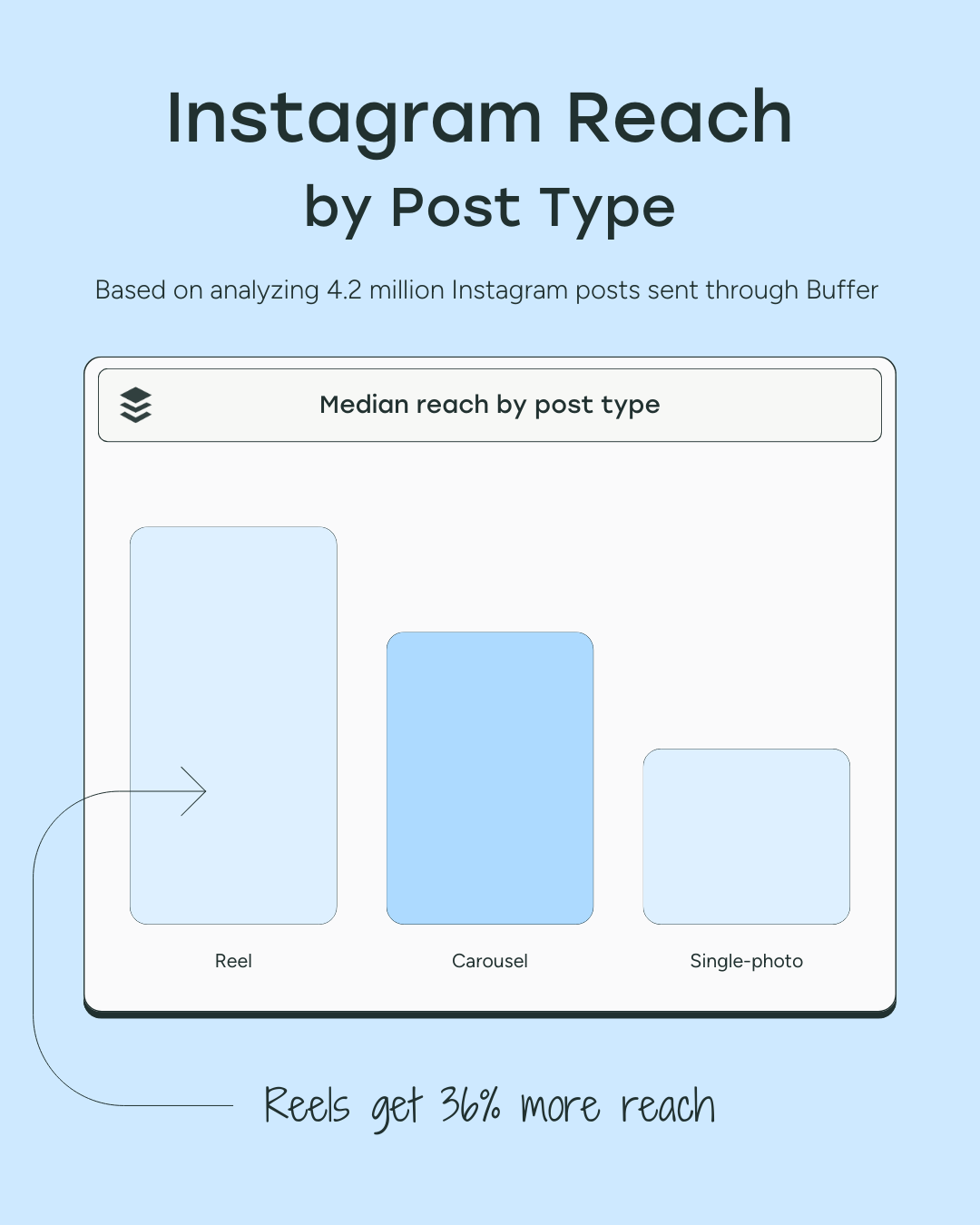
Reels are still your best bet if your goal is visibility. Use them to grow your audience, test ideas, and introduce new content series. And try out features like trial reels or adopt new hashtags to reach new eyes.
And Buffer’s connection growth for TikToks, shorts, and reels all point the same way — audiences are primed for quick, vertical video no matter where they scroll. That appetite is exactly what keeps Reels at the top for reach on Instagram.
Carousels drive the most engagement — by a clear margin
When it comes to likes, comments, and shares, carousels win. They receive:
- 12% more engagement than Reels
- 114% more engagement than static images
- The highest save rate across all post types
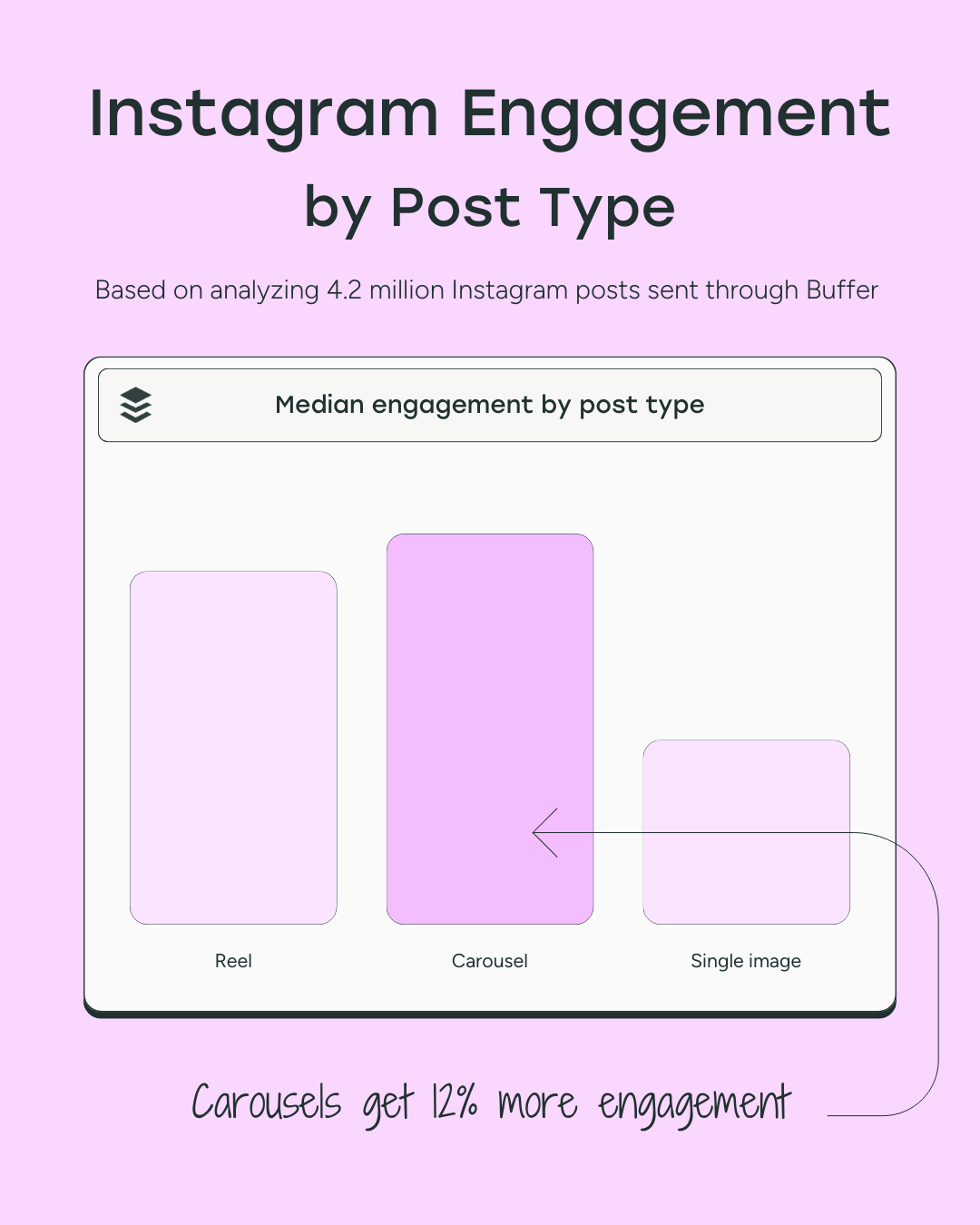
The reason for this is pretty clear: Carousels keep people swiping, and the Instagram algorithm loves content that keeps people on the platform. Carousels are also perfect for educational content, story-driven visuals, or value-packed slides that people want to revisit later.
Use carousels to go deep on a topic. Think checklists, breakdowns, before-and-afters, or multi-step guides.
Content performance shifts by account size
What works for an account with 5,000 followers won’t always work for one with 500,000. Here’s how performance scales on Instagram, according to Socialinsider:
- Smaller accounts (under 10k) see higher reels view rates (up to 20%) and stronger story reach
- Mid-sized accounts (50k–200k) benefit from balanced strategies — reels for reach, carousels for community
- Large accounts (100k+) see better comment and save rates on static images and carousels — likely due to loyal audience behavior
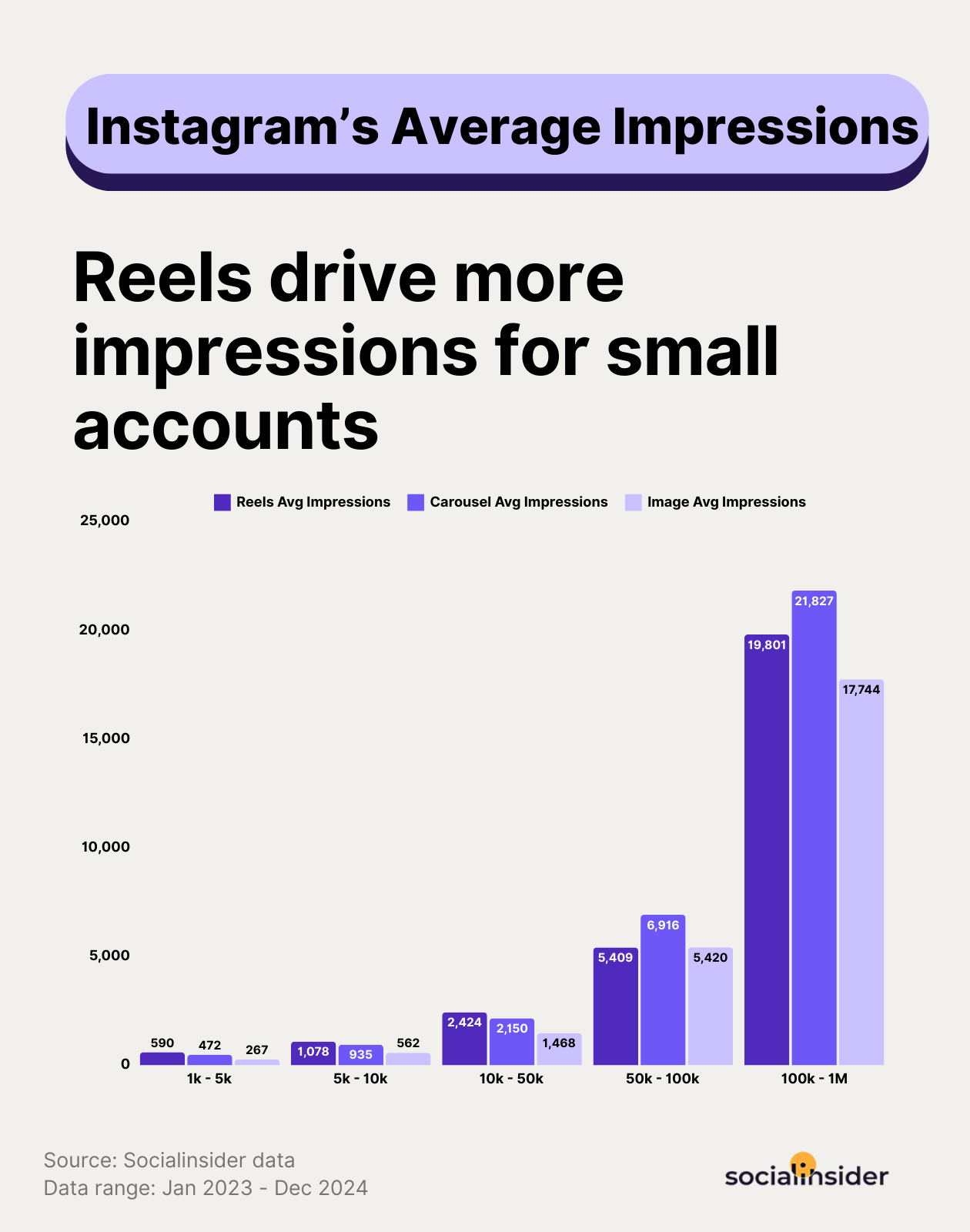
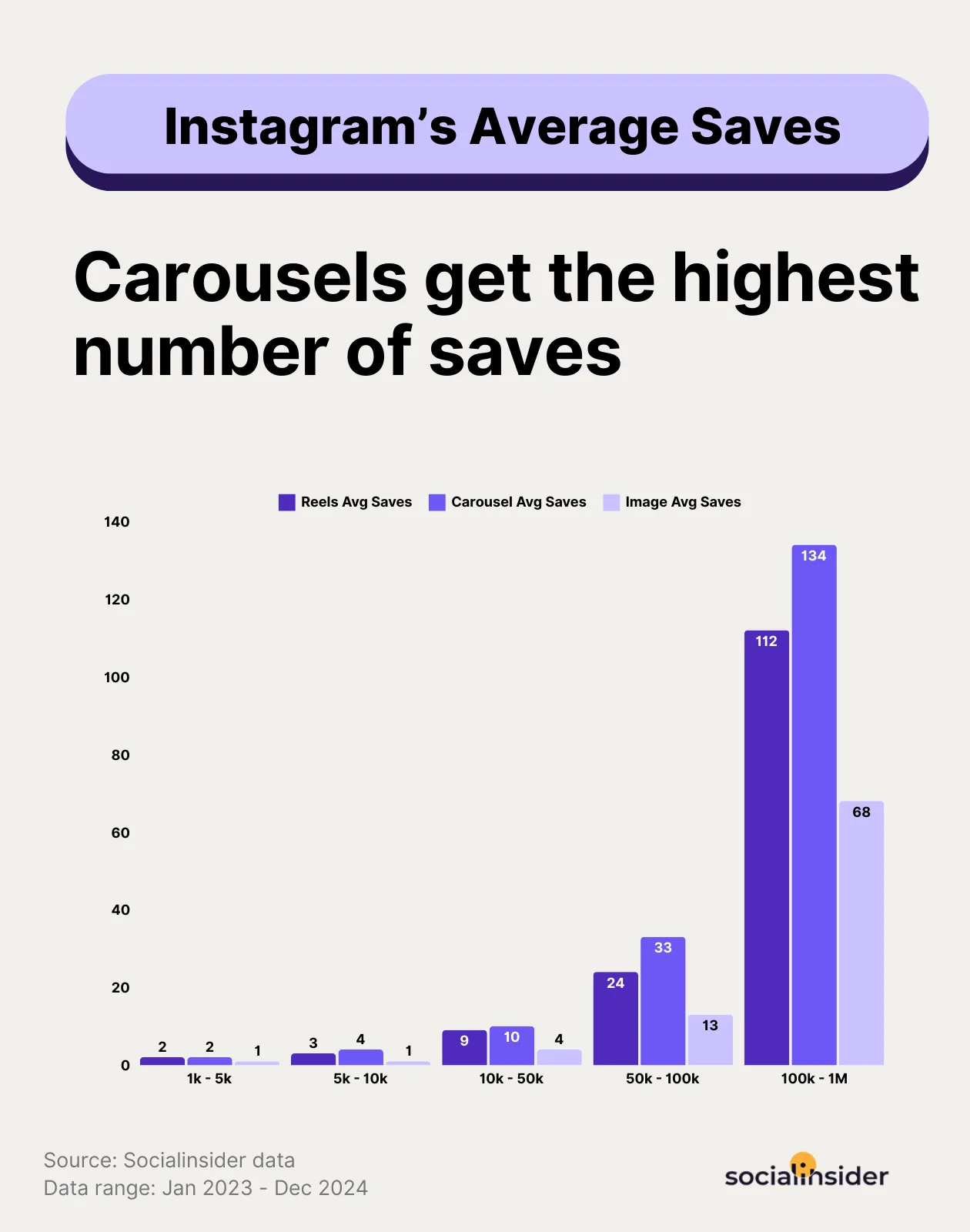
The lesson here is to tailor your content format to your growth stage. Small accounts should create content that gets them discovered. And the bigger you get, the more the content should resonate to keep existing followers engaged.
The best time to post on Instagram is between 3 and 6 p.m. on weekdays
After analyzing more than 2 million Instagram posts, we found that the best time to post on Instagram is generally 3 p.m. and 6 p.m. on weekdays.
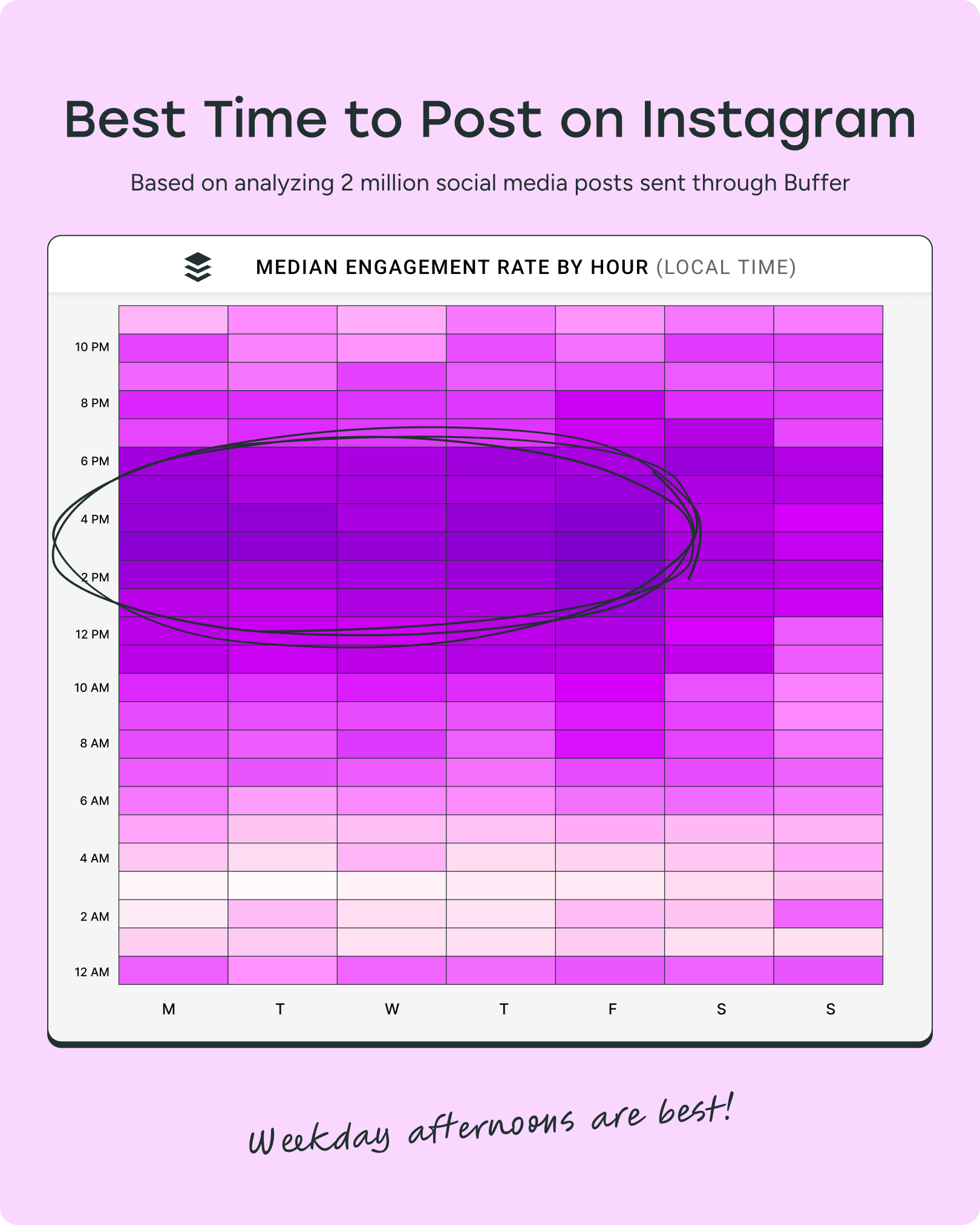
The best day to post on Instagram is Friday
Our research also found that Friday is the best day to post on Instagram, closely followed by Monday. But overall, you can’t go wrong posting on a weekday.
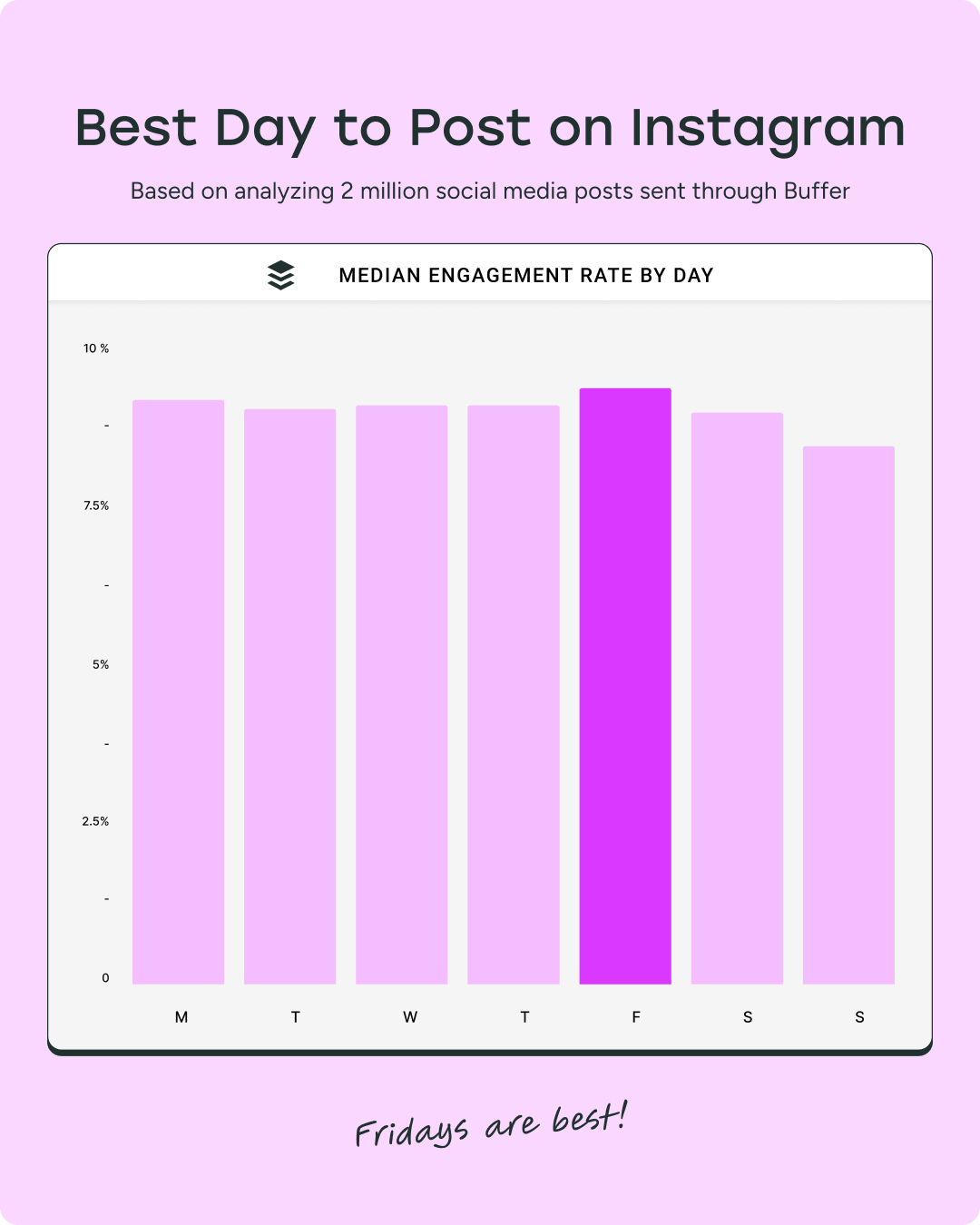
Brands and creators on Instagram
Instagram has long been the go-to platform for visual storytelling, and in 2025, creators and brands are doubling down. But what’s changing isn’t whether they show up — it’s how. From nano-influencer dominance to format strategies that actually drive results, this section unpacks what’s working right now for the people using Instagram to grow a business, build trust, and create community.
Nano-influencers make up 77% of all creators on Instagram
According to Statista, nano-influencers (1k–10k followers) account for 75.9% of all influencers on the platform. Micro-influencers (10k–100k) make up another 13.6%, with only a small fraction falling into the macro or celebrity tier (3.5%).
You don’t need a massive following to have impact. For brands, this means there’s a huge pool of niche creators with high engagement across the platform's audience — ideal for authentic partnerships and lower-cost campaigns.
Smaller accounts get more reach per post
Accounts under 10k followers aren’t just more common — they often outperform larger accounts in key metrics:
- Reels view rate: 20%
- Instagram Stories reach rate: up 35% YoY
- Higher save rates per follower
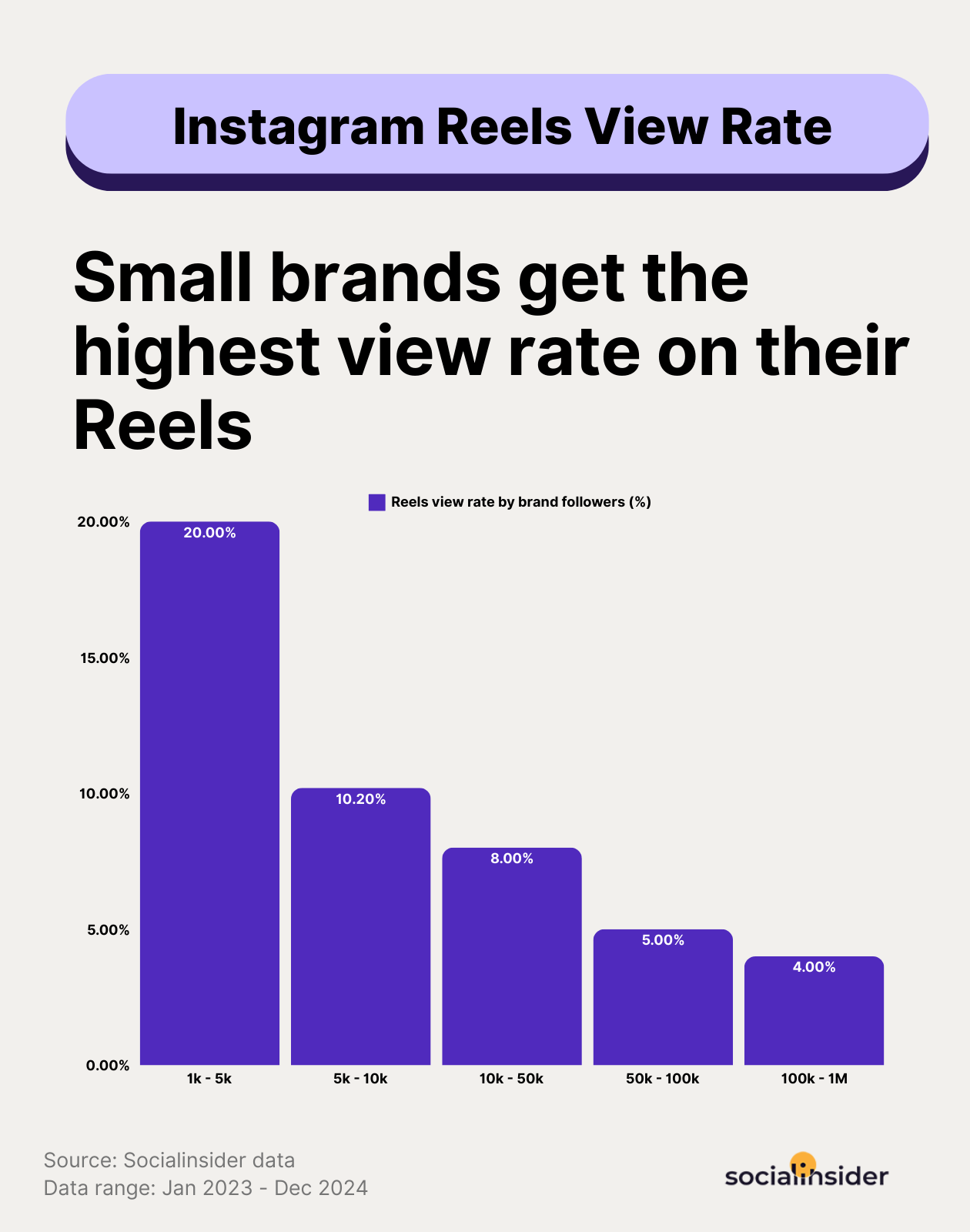
This is because Instagram’s algorithm favors newer or smaller creators to keep the content feed fresh. Plus, smaller accounts often feel more personal and approachable — a major driver for engagement.
If you’re growing from scratch, lean into reels + Instagram Stories + educational carousels. Don’t wait to “look big” before showing up consistently.
Follower growth is fastest for small and mid-sized accounts
Socialinsider found that the fastest-growing Instagram accounts in 2025 are still in the 1k–50k range:
- 1k–5k: 38% average growth
- 5k–10k: 35%
- 10k–50k: 33.8%
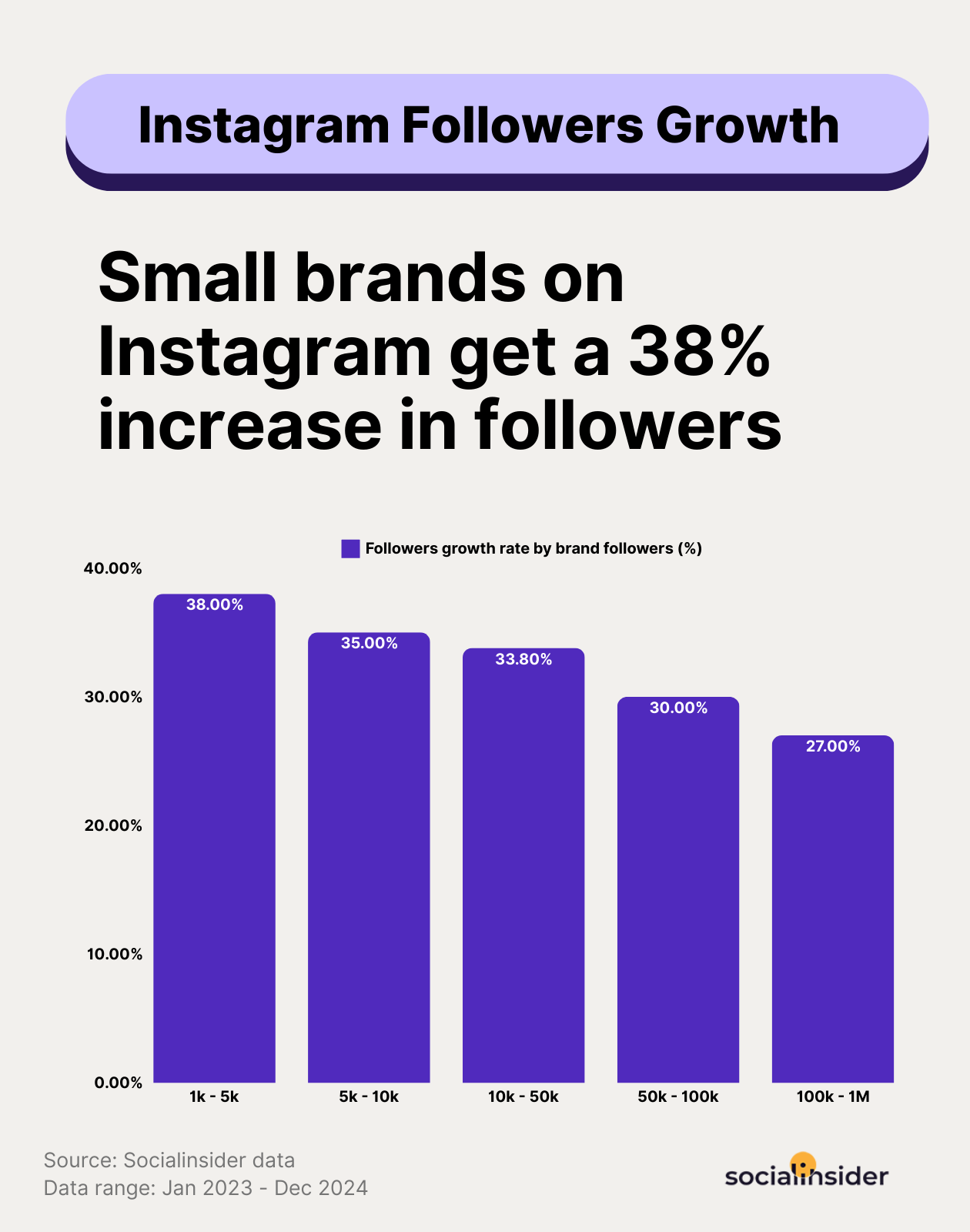
The bigger an Instagram account gets, the harder it is to grow. That doesn’t mean growth stops; it just happens more slowly, and the strategy for growth changes accordingly. That means every stage of growth has a strategy:
- Small accounts → focus on visibility
- Mid-sized accounts → build community
- Large accounts → double down on value and retention
Reminder: Don’t copy a content strategy from an account 100x your size. What works for them may not serve you — yet.
Where the money goes on Instagram
Instagram isn’t just where people scroll — it’s where people spend. In 2025, Instagram remains one of the most commercially active platforms, whether it’s through influencer partnerships, product discovery, or DMs that lead to real sales. These Instagram statistics explores how money moves on the platform — and how smart brands and creators are turning attention into action.
44% of users shop on Instagram weekly
Instagram isn’t just a discovery platform — it’s a storefront. According to Instagram’s own research, 44% of users interact with shoppable content or browse for products at least once per week.
Even without the dedicated “Shop” tab, product discovery happens through:
- Creator and influencer partnerships
- Tagged products in Reels and carousels
- Stories with direct links
- DM-based selling (especially for small businesses)
Even if you’re not “selling on Instagram,” your audience might be ready to buy. Make it easy for them to act.
The smallest Instagram influencer rates start from $100
Instagram influencers across all tiers are highly sought after for good reason. Between the potential eyes on their content with the platform’s 2-billion-strong user base and various features, there are many options for brands across different industries.
There’s a generally accepted Instagram influencer rate of $100 per 10,000 followers, which can change based on the number of posts requested, the influencer’s metrics, the industry in play, the value of an influencer’s audience to a brand, and many other factors.
According to a survey by Impact.com, estimated Instagram rates break down as follows:
- Nano-influencers (500–10,000 followers): $500 to $2000 per post
- Micro-influencers (10,000–50,000 followers): $2000 to $8000 per post
- Mid-tier influencers (50,000–100,000 followers): $8000 to $20,000 per post
- Macro-influencers (100,000–500,000 followers): $20,000 to $45,000 per post
- Mega-influencers (500,000+ followers): $45,000+ per post
Instagram influences more purchases than any other platform (after YouTube)
A 2024 RetailDive study found that Instagram influences more consumer purchasing decisions than TikTok, Facebook, or Pinterest — second only to YouTube.
It’s not always about conversion on-platform. Instagram content often drives:
- Brand awareness
- DM inquiries
- Site traffic
- Wishlist saves or screenshot purchases
The lesson here is that Instagram’s value for generating sales goes beyond that discovery on the platform. It’s often the first place someone finds you — or the last place they get convinced to purchase from you.
What these Instagram statistics mean for your strategy in 2025
In 2025, Instagram still has the range, but standing out means getting specific. With over 2 billion monthly users and several content formats and features competing for attention, growth no longer comes from posting more but from posting strategically.
These Instagram stats show us that:
- Reels still drive the most reach
- Carousels spark the most saves, and
- Smaller accounts often outperform larger ones on core engagement metrics.
But behind those numbers is a deeper shift: audiences are more fragmented, engagement is increasingly private, and success looks different depending on your size, goals, and niche. That’s why the best Instagram strategies right now don’t involve virality or trend-chasing but lean into consistency, building a core audience, and make space for both discovery and depth.
You don’t need to go viral every week. You just need to be memorable, helpful, and worth returning to. Let the numbers guide you and let clarity drive your next post.
Sources
https://datareportal.com/essential-instagram-stats
https://datareportal.com/reports/digital-2024-july-global-statshot
https://datareportal.com/social-media-users
https://www.statista.com/topics/1882/instagram/
https://auraagncy.com/2024-instagram-stories-benchmark-report/
https://www.socialinsider.io/social-media-benchmarks/instagram
Try Buffer for free
140,000+ small businesses like yours use Buffer to build their brand on social media every month
Get started nowRelated Articles
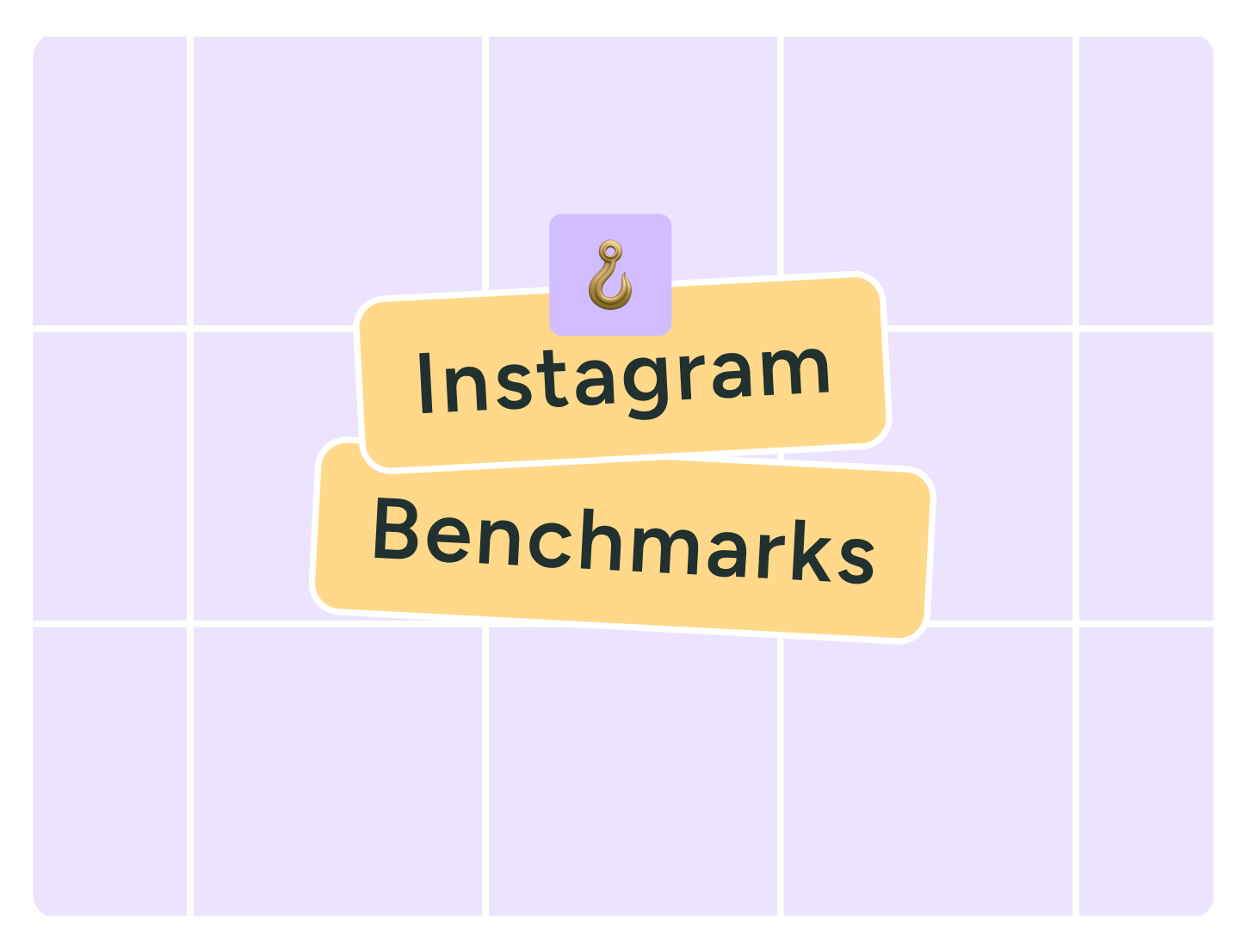
In this article, we’ll break down the average Instagram engagement rate by follower tier and share what the numbers actually mean in practice.
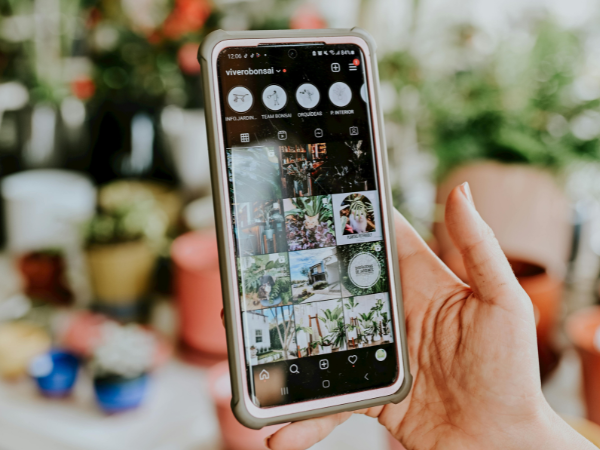
Your Instagram posts can now appear on Google. Learn the ins and outs of Instagram SEO so your content and profile rank at the top of search results
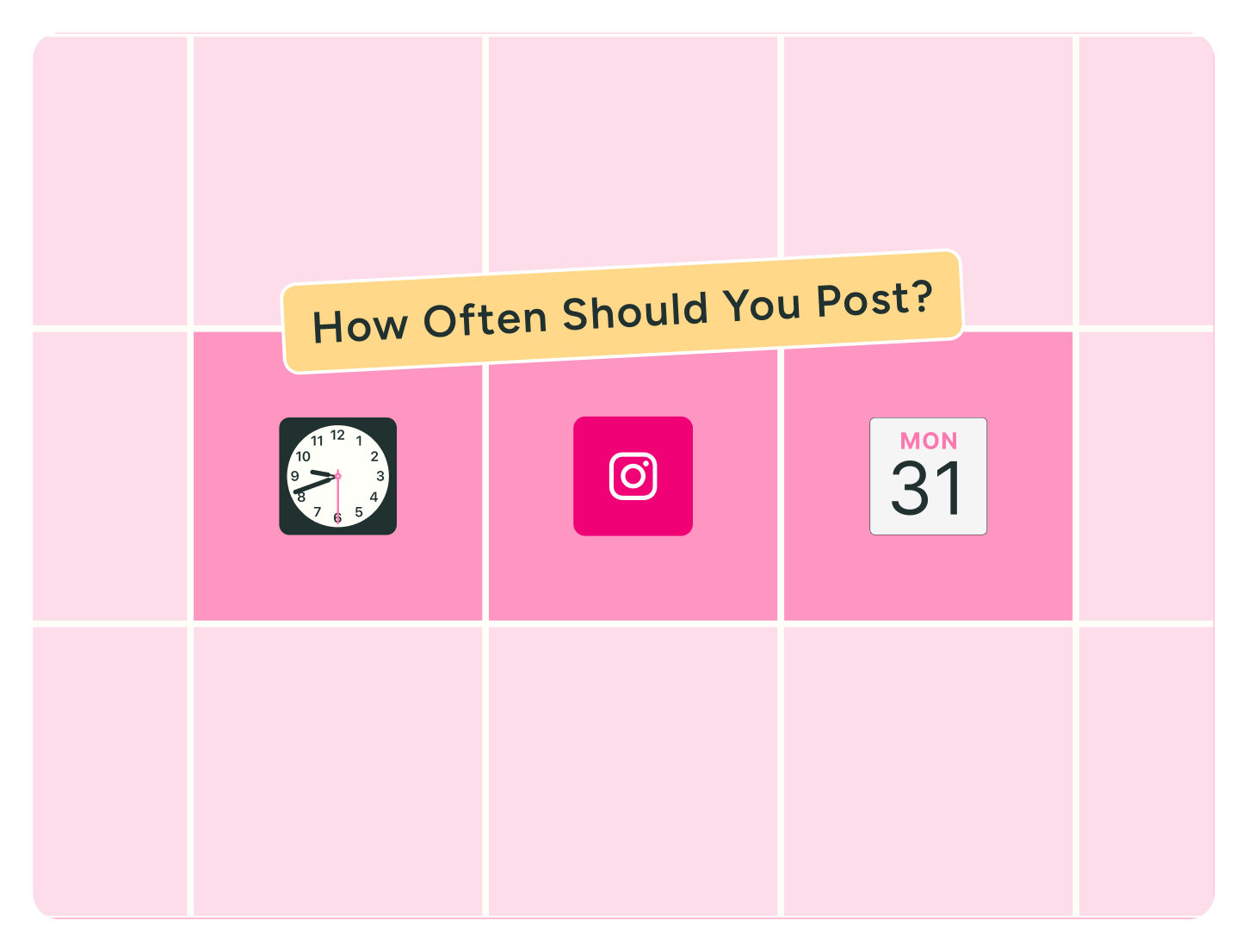
Data-backed guidance on how often to post on Instagram in 2025 for maximum reach and growth. Insights from 2M+ posts reveal the sweet spot for frequency without burnout.